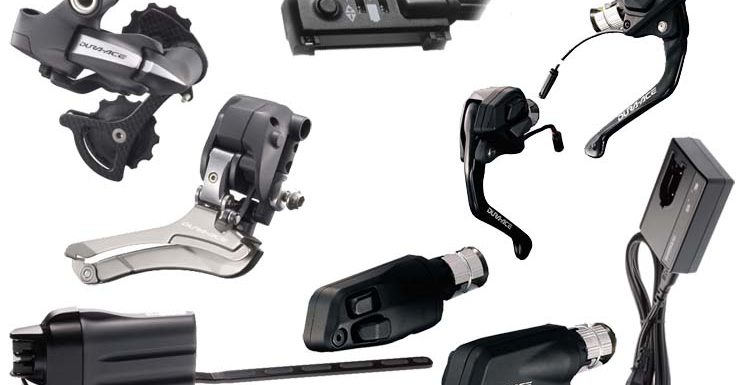
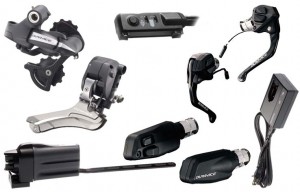 I learned quite a bit about Shimano Di2 when I installed one of the first available Time Trial/Triathlon groupsets on my Cervelo P2. I’ve subsequently answered a lot of questions on forums and article comments, and elsewhere. In doing so, I realized that people have a lot of questions about Di2 and the answers are difficult to find. This lead me to create this article, to consolidate everything I know and have been asked into one location so people can find answers. If you can’t find what you’re looking for below, please leave a comment and I’ll do my best to help.
I learned quite a bit about Shimano Di2 when I installed one of the first available Time Trial/Triathlon groupsets on my Cervelo P2. I’ve subsequently answered a lot of questions on forums and article comments, and elsewhere. In doing so, I realized that people have a lot of questions about Di2 and the answers are difficult to find. This lead me to create this article, to consolidate everything I know and have been asked into one location so people can find answers. If you can’t find what you’re looking for below, please leave a comment and I’ll do my best to help.
Index: There’s lots of info in this post, so here’s an Index to help you find specific sections:
- Di2 General Overview
- Compatibility: Between 6770 10-speed, 6780 11-speed, 9070 11-speed, first-gen 7970
- How to Check Battery Level
- How to Adjust Rear Derailleur Trim
- How to Adjust Front Derailleur Trim
- Dealer Installation Manuals
- Shimano E-tube Project Software – Change Settings and Update Firmware
- Chargers, PC USB Interfaces/Programmers
- Component Overviews
- Shift/Brake Levers
- Dedicated Shift Buttons
- Front Derailleurs
- Rear Derailleurs
- Display Units and ANT Bluetooth Wireless Communication Modules
- Batteries and Battery Mounts (Internal and External)
- Front Cable Connection A Junctions (with charger ports and LED status lights)
- Rear Cable Connect B Junctions
- Cables, Grommets, Cable Install Tools
- List of Components Needed to Build Your Own Di2 System
- Technical Details of the Di2 CANBUS protocol and signaling
System Overview: Shimano Di2 Dura-Ace 9150 and 9070 and Ultegra 6770 and 6870
The second generation Shimano Ultegra 6770/6870 and Dura-Ace 9070 “E-Tube” electronic bicycle shifting systems consist of battery-powered electric derailleurs activated by handlebar mounted push buttons. Power and shift commands are sent via a 2-wire CAN (Controller Area Network) datalink contained within a single cable housing. This design has several advantages over conventional mechanical shifting systems, the most notable of which are:
- Extremely low shifting effort, which generally results in more frequent shifts and therefore better gear ratio selection.
- Greatly improved shift quality, especially for the front derailleur chainrings, allowing shifting under full power with almost no chance of a dropped chain.
- Shifting is available at multiple positions on the handlebars, for example, at the end of the time trial aero bars, on the brake levers, up to in climbing position, and down low the sprint position.
- Automatic trimming of the front derailleur position as the rear derailleur moves back and forth between the smaller and bigger gears. This eliminates unintended contact (and noise) between the front derailleur and the chain.
- Lighter weight vs. equivalent mechanical system. The Shimano Dura-Ace Di2 9070 electronic groupset with internal battery weighs 2047 grams; the Shimano Dura-Ace 9000 mechanical groupset weighs 2074 grams (27 grams more than Di2.)
- Multi-Shift: Pressing and holding a rear derailleur shift button results in shifts through multiple gears. The rate of shifts can be configured using the PC computer interface cable and the free Shimano E-tube Project software.
- Synchronized Shifting: Starting with Dura-Ace 9150, automated Synchronized Sifting of the front derailleur is an option. Two SHIMANO Synchronized Shift modes will be available:
- Full SHIMANO Synchronized Shift: the front derailleur reacts based on the rear derailleur’s shift action. This essentially means that, when activated, there is no need for two separate shifters to control front and rear derailleurs, the two buttons on one shifter will control both derailleurs.
- Semi SHIMANO Synchronized Shift mode: the rear derailleur reacts based on the front derailleur’s shift action, shifting to the next most appropriate rear gear when the rider makes a front shift.
- R9120, R9170 – syncroshift enabled with firmware 3.2.0 or newer
- 6870, 9070 – syncroshift enabled with firmware 3.2.1 or newer
- 6770 – no syncroshift firmware update will be offered
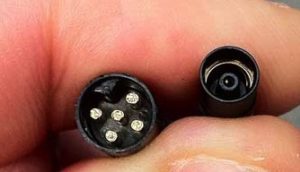 Historic Info on the older first generation 5-wire Shimano Dura-Ace Di2 DA-7970 system and how it compares to the new E-tube 2-wire system:
Historic Info on the older first generation 5-wire Shimano Dura-Ace Di2 DA-7970 system and how it compares to the new E-tube 2-wire system:
Released in 2009, the 7970 operated using a very basic 5-wire electronic system. Each shift button was connected to a different wire; shorting the specific wires together controlled the derailleur upshifts and downshifts. Because the first generation 7970 used completely different technologies than the newer 2-wire systems, none of the components are cross-compatible. At this point, Shimano is not expected to offer any updates or new components using the first generation 7970 architecture; everything from now on will be based on the newer 2-wire E-tube design. The second generation design offers several advantages, which include: 1) smaller wire size, smaller connector size, waterproof connectors; 2) all switches can be reconfigured in software to send upshift or downshift commands to either the front or rear derailleur; 3) firmware updates can add new features (such as multi-shift) and compatibility with new components.
Compatibility: Dura-Ace 9070 and Ultegra 6770 / 6870 (and old 5-conducter 7970)
The confusing naming system used by Shimano makes it difficult to figure out what each component is, much less what is compatible between systems. Here are some compatibility guidelines:
- Nothing from the first generation (4-conductor / 5-conductor) Dura-Ace Di2 7970 system is compatible with any other newer system. It was replaced by the (2-conductor) E-tube systems. No parts are inter-operable between 7970 and any other Di2 System.
- In general, every electronic Di2 component is compatible between the Ultegra 6770, 6870, and Dura-Ace 9070 systems (see exceptions below.) This means that all of the road bike Ultegra/Dura-Ace dual control brake levers/shifts, time trial shifters, and climbing shifters can be used with either Ultegra 6770/6870 or Dura-Ace 9070 front and rear derailleurs. Any of the Ultegra/Dura-Ace controllers (A Junctions) can be used with either system. All components use the same cables and connectors.
- Firmware Update Required to Make Older Components Compatible with Newer Components: If you add a new component and it doesn’t work, update the firmware using the PC USB adapter and the Shimano E-tube Project Software for Windows.
- Synchronized Shifting and Bluetooth Wireless Units can be added to all E-tube Ultegra and Dura-Ace systems but the battery has to be upgraded to the BT-DN110 Internal Battery or BM-DN100 External Battery Mount. To add Bluetooth capability, a EW-WU101 or EW-WU111 inline transmitter must be added to road bikes and for mountain bikes, the SC-MT800 or SC-M9051 display/transmitter unit must be added.
- Compatibility Exceptions:
- Note 1 – Sprint Shifter Exception: The Sprint Shifter is the only exception for shifter incompatibility. It has a different wiring connector (and internal components) that can only plug into a unique/dedicated third port on the Dura-Ace ST-9070 Dual Control Brake Levers/Shifters and also the ST-6870 Levers. There is no sprint shifter port on the ST-R785 Hydraulic Levers.
- Note 2 – Can’t mix 10-speed/11-speed front/rear Derailleurs: It is no longer possible to use a 10-speed front derailleur with an 11-speed rear derailleur (and 11-speed front with 10-speed rear.) See note farther below to read the history on this if you want all the messy details.
- Note 3 – Front A junction and Internal Battery: Since the February 2015 firmware update, the older SM-EW67-A-E Front Junction A is no longer compatible with the BTR2 Internal Battery because it does not have the charging port to charge the internal battery. The SM-EW90 Front Junction (with integrated charging port) should be used instead. The SM-EW67 still works with the external battery.
- Note 4 – Update the Firmware to make components compatible: If the firmware on all components is not updated to the latest version, some components may be not operate correctly with one another. So download the latest E-tube software and update everything and it should work.
- Note 5 – All Shifters work with all 10-speed and/or 11-speed Rear Derailleurs: All of the shifters are compatible with either the 10-speed Ultegra 6770 or 11-speed Ultegra 6870/Dura-Ace 9070 systems as long as they all have the latest firmware. The rear derailleur is the only component that “knows” or “cares” how many rear gears are available. The shifters only send upshift/downshift commands and do not “know” or “care” which gear is currently selected and how many total gears there are.
- Note 6 – SM-BTR1 External Battery and SM-BMR1 Mount firmware updates: The more expensive dedicate service tool (SM-PCE1 PC Interface) must be used to upgrade the firmware on the external battery/mount.The external battery and battery mount can not receive firmware upgrades via the SM-EW90 Front Junction A and the SM-BCR2 PC Interface/Battery Charger. (The SM-EW90 will work in a system with an external battery, but a firmware update can cause them to become incompatible until both are updated independently using the appropriate PC Interface and the Shimano E-Tube Project software.)
- See the Shimano E-tube compatibility chart version 3.4.3 for more details
Compatibility: 11-Speed Rear Derailleur and 10-speed sprockets/wheels
The 11-speed Dura-Ace 9070 and Ultegra 6870 rear derailleurs are designed exclusively for 11-speed rear sprockets and 11-speed Front Derailleurs. Shimano does not provide a way to recalibrate/reprogram them for a 10-speed setup. The sprocket spacing is slightly smaller and the overall range of travel slightly longer on 11-speed systems. If you have 10-speed wheels and 10-speed sprockets, you should use the 10-speed RD-6770 rear derailleur and a 10-speed FD-6770 front derailleur.
Similarly, a 10-speed RD-6770 rear derailleur should not be used with 11-speed sprockets. There will be chatter in some gears, and there might be slow-shifts or self-shifts.
It doesn’t matter which shifters are used; the shifters send upshift/downshift commands regardless of which derailleur config is being used. Shifters do not “know” or “care” which gear is currently selected and how many total gears there are.
Front Chain Rings: In general, most any front chain rings will work, rigid forged rings work best with Di2 due to high front derailleur shift forces. Shimano chain rings tend to be the best, but most others work as well. A 10-speed specific or 11-speed specific chain should be used, but the differences between them are minimal and can generally be mixed/matched without issue.
How to convert “non-upgradeable 10-speed only” wheels such as Zipp 900/Sub9 Disc Wheels to 11-speed: “the spacing between a Campy 11 and Shimano 11 is close enough that you can use the cassettes interchangeably. If you get a Campy free hub body, the 2 shims (part# is on the Zipp website, just search for Campagnolo 11) and a Campy cassette and you’re ready to ride with all 11 cogs available to use.” via slowtwitch.com
But it’s an emergency and I need to use a 10-speed wheel. . . In emergency situations, 11-speed rear derailleurs can be used with 10-speed sprockets. There will probably be chatter in some gears, and there might be slow-shifts or self-shifts. To setup an 11-speed rear derailleur for a 10-speed sprocket setup, adjust the mechanical limit screw so that it can’t shift into the missing 11th sprocket position, then follow the rear derailleur adjustment procedures listed below.
Included for very motivated individuals only: 10-speed front derailleurs can be used with 11-speed rear derailleurs if the shifters and battery have firmware installed from E-tube software version 2.5.2 or earlier. Shimano disabled support for this 11-speed and 10-speed cross-matching with later firmware updates. For informational purposes only, the details of how to regain compatibility are detailed below.
- Important Notice 2014-07-14: There is a compatibility issue with Shimano e-Tube software/firmware versions v2.6.0 and later that prevents 10-speed front derailleurs (FD-6770) from working with 11-speed rear derailleurs (RD-6870) and 11-speed front derailleurs (FD-6870) from working with 10-speed rear derailleurs (RD-6770). DO NOT UPDATE FIRMWARE using Shimano e-Tube software v2.6.0 or later if you are mixing an FD-6770 front derailleur and a RD-6870 11-speed rear derailleur, or a FD-6870 with a RD-6770.
- The problem component is the battery (external battery mounts SM-BMR1 and SM-BMR2, internal seat post battery SM-BTR2.) If you keep battery firmware at v2.0.6 or earlier, the system will continue to function properly. Shimano e-Tube Software v2.6.0 will update battery firmware to v3.0.5, and will not allow the RD-6870 to work with a FD-6770 setup.
- If the battery firmware is updated to 3.0.5, it CAN NOT be rewritten back to the older version. You will need to need to replace a derailleur so that both are 6770 10-speed or so that that both are 6870 11-speed. (The other option is to get get a battery with the older firmware and never update it.)
- Here’s a link to the “last known good version” of the Shimano e-Tube software to work with a mixed 10-speed/11-speed system: E-tube_Proj_V_2_5_2.zip Use this version and do not connect to the internet when using it so that E-tube can’t check for updates when open.
- To roll-back newer versions of battery and shifter firmware, install E-tube version 2.5.2 and made a copy of “C:\ProgramData\E-tube Project\FW” which has all the firmwares packaged in that version of E-tube. Next, install the latest version of E-tube. Then copy all the firmwares from the the 2.2.3 version back to the same location “C:\ProgramData\E-tube Project\FW” for the latest version (note: ProgramData is a hidden directory, click here for details on how to view it.). Next, the trick is to find the firmware you want to downgrade (pretty easy from the name and version in the file name), and then rename it to the same name as the latest version, but increment the last version digit by one. Then connect to the bike with E-tube (without an internet connection) and it will identify that a firmware upgrade is available for that component and allow you to do the firmware “upgrade” to the older version of firmware. Now exit E-tube and then rename the firmware file back to original to prevent the issue in future. E-tube will then try to upgrade again but just don’t let it do that. This should get a bike that did nothing (not even enter adjustment mode) to a fully working state by reverting the battery and shifters. Running latest firmware in derailleurs seems to be fine. (thanks to commenter vosadrain)
- It will not be possible to charge the BTR2 internal battery using the BCR2 USB charger unless you also downgrade the firmware of the BCR2 USB charger as well.
- Note however that latest E-tube software will say the setup is unsupported and will not allow programming. To do programming, disconnect the internal battery and connect a spare external battery. This allows making settings changes. To program the BTR2 itself, I just connect to the BTR2 by itself (no other components) and the E-tube software will allow firmware changes to it. Or try using the 2.5.2 version of E-tube.
- Alternatively, buy a Di2DIY internal seat post battery kit and you will not have to go through the firmware downgrading. The kit makes it possible to run all components with the latest E-tube firmware. Also worth noting some firmware updates were done to fix power distribution errors in the FPGA’s that would allow the batteries to drain down when the bike was just sitting.
Checking Battery Charge Level:
A single battery charge should give at least 1500 miles of riding. Most riders will not need to charge the battery more than twice a year.
To check the battery charge remaining, press and hold any shifting switch for 0.5 seconds or more. The amount of battery charge remaining will be indicated by the light on Front Controller A Junction.
- 100% remaining: Illuminates green (for 2 seconds)
- 50% remaining: Flashes green (5 times)
- 25% remaining: Illuminates red (for 2 seconds)
- 0% remaining: Flashes red (5 times)
When the battery charge is low, first the front derailleur will stop operating, and then the rear derailleur will stop operating. When the battery charge has been fully spent, the derailleurs will be fixed at the last gear shifting position. If the battery indicator is illuminated red, it is recommended that you recharge the battery as soon as possible.
Adjusting the Rear Derailleur Trim:
If you switch between multiple rear wheels, it’s very likely that the sprockets on different wheels won’t be in exactly the same relative position to the rear derailleur, resulting in that annoying clicking sound as the chain makes contact with an adjacent sprocket. Follow the steps below to properly align the rear derailleur with the rear sprockets.
- Shift the rear derailleur to the 5th sprocket position. Press the button at the junction (A) of the SM-EW67-A-E until the red LED illuminates in order to switch to rear derailleur adjustment mode. Note that if you keep pressing the button after the red LED has illuminated, protection recovery operation will begin.
- If shifting switch is pressed once while the initial setting condition is active, the guide pulley will move one step toward the inside. If shifting switch (Y) is pressed once, the guide pulley will move one step toward the outside.
- Note: The guide pulley can move 15 steps inward and 15 steps outward from the initial position, for a total of 31 positions.
- Note: When adjusting, the guide pulley will overrun slightly and then move back in an exaggerated movement so that you can check the adjustment direction. When checking the positions of the guide pulley and the sprocket, check at the position where the guide pulley finally stops.
- While turning the front chainwheel, operate shifting switch to move the guide pulley toward the inside until the chain touches the 4th sprocket and makes a slight noise.
- Next, operate shifting switch 4 times to move the guide pulley toward the outside by 4 steps to the target position.
- Press the button at junction (A) until the red LED turns off in order to switch from rear derailleur adjustment mode to gear shifting mode. Shift to each gear and check that no noise is generated at any gear position. If fine adjustment is needed, switch back to adjustment mode and readjust the rear derailleur.
- Note: if you have customized your shifters and swapped buttons, this will change which shifter and buttons control the micro-adjustments. Also, if you hit the wrong buttons while trying to set the FD trim, you can actually alter the setup of your RD. Be certain that you’re hitting the correct adjustment buttons.
- If you have a Garmin or similar head unit and a SM-EWW01 ANT module, the display will automatically switch into derailleur trim display when you activate that mode (i.e. by pressing the button at the junction (A) of the SM-EW67-A-E.) It will give you the trim position in either + or – 12 positions. When switching wheels, simply take note which position suits which wheel/sprocket/trainer, and trim to that level each time you change. This removes the guesswork and makes changing from wheel to trainer simple.
Note on FD-6870 Front Derailleur Trim:
The FD-6870 trim adjustment effects the auto-trim positions. The adjustment feature is accessible via either the A-Junction box, or the “Front derailleur adjustment setting” in the e-tube software, and should be used only after you have already set the physical inner/outer limit screws. So for example, if the FD outer plate rubs the chain when using the 6th largest cog, you would want to adjust the FD trim outward a couple ticks. However, you can only perform this adjustment while in the big-ring/big-cog combination. Etube forces the derailleurs into this maximum cross-chained position, whereas during the manual method you must shift to these positions yourself. (Thanks to commenter Bryan B for the info.)
Dealer Manuals:
The dealer’s manuals contain the most detailed information available from Shimano. If you’re looking for detailed installation instructions, check here:
- Shimano Ultegra 6770 Dealer’s Manual: http://techdocs.shimano.com/media/techdocs/content/cycle/SI/Ultegra/UltegraDi2/6770Di2_DM_EN_v1_m56577569830773882.pdf
- Shimano Ultegra 6870 Dealer’s Manual: http://si.shimano.com/php/download.php?file=pdf/dm/DM-UL0001-00-ENG.pdf
- Shimano Dura-Ace 9070 Dealer’s Manual: http://si.shimano.com/pdf/dm/DM-DA0001-00-ENG.pdf
- Shimano Alfine Di2: http://si.shimano.com/php/download.php?file=pdf/dm/DM-AL0001-03-ENG.pdf
Shimano E-tube Project Configuration and Firmware Update Software for Windows:
Shimano E-tube Project Wireless for iOS and Android: Announced on April 15, 2016 but as of yet unreleased, these apps will allow configuration of shift profiles (multi-shift on/off, multi-shift delay between shifts, shifter button assignments) and firmware updates over Bluetooth. To function, a Shimano Di2 Bluetooth Adapter, such as the MT800 digital display, is required.
Shimano E-tube Project Windows PC Software: This free software is used to update the firmware of all components. It works with the SM-BCR2 Charger + USB Adapter and the SM-PCE1 Diagnostic Adapter. The software is used to change the configuration of each shift button / lever (any can be programmed to upshift or downshift either the front or the rear derailleur.) It can also be used to enable multi-shift (multi-shift is where the shifter is held and the rear derailleur shifts through multiple gears until the shifter is released.) The delay between of the gear changes during multi-shifting can also be adjusted. The software is available from http://e-tubeproject.shimano.com/
Older versions of the e-tube software are available from these links: 2.5.2
PC & Mobile Interfaces, Chargers, and Software:
SM-BCR1 Battery Charger: This is used to charge the external battery. The part number for the battery charger wall cord is SM-BCC1.
SM-BCR2 Charging and PC Connection: for SM-EW90-A 3-port and SM-EW90-B 5-port A Junctions. This plugs into a special port on the side of the A junctions (which is covered by a rubber flap.) This adapter charges the internal battery when first plugged into the A junction; it must be powered by a standard USB Wall charger (such as that used for an Apple iPhone) or a PC that is powered-on. If the Shimano E-Tube Project Software is launched on the Windows PC with the SM-BCR2 attached, the SM-BCR2 will switch from charging mode to configuration mode. It must be detached from the computer and reattached to switch back to charging mode.
- It takes about 2 hours to charge the internal battery.
- Amber light=charging.
- Light turns off when done.
- If the Amber light does not come on when plugged in, this indicates battery is not discharged enough to charge.
- Light flashing indicates something is wrong, like trying to charge a external battery through a BMR.
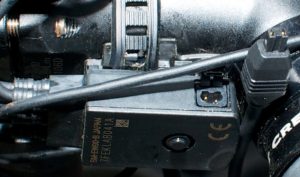
Hacking the SM-BCR2 to have a standard Di2 cable connector: If your 3-port or 5-port junction is inaccessible for charging, there is an alternative hack method to connect it to the system through a standard Di2 port. With basic soldering skills you can hack the BCR2 to be used with any setup. Buy any length EW-SD50 wire, cut off one end. Cut the wire on the output side of the BCR2. Splice the two wires together, so that the output wire of the BCR2 is now a standard Di2 connector. The charger has an inner (white) and outer (shield) wire; connect the inner white wire to the SD50 red wire; connect the charger outer shield wire to the SD50 black wire. You will then be able to plug the BCR2 into any Di2 port. Or use a SM-JC40 junction B and another length of EW-SD50 wire and go through the RD (by using the SM-JC40 to connect the rear derailleur, new output wire of the EW-SD50, and the wire that ordinarily connect the rest of the system to the rear derailleur.) Thanks to @Di2diy for the info.
SM-PCE1: This PC Configuration and Diagnostics adapter will not charge the internal battery. It offers the same configuration options as the SM-BCR2, but also add some advanced diagnostic and troubleshooting features that the SM-BCR2 does not have. It attaches to via the standard E-tube wire (just like the EW-SD50 cables) rather than to a dedicated port on the side of the front A junction.
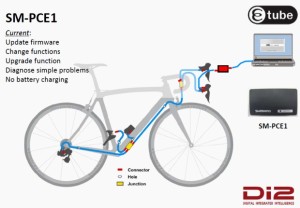
Bluetooth and E-tube Apps for Apple iOS and Android: Bluetooth wireless modules are available to allow system settings to be adjusted via the mobile applications that connect via Bluetooth Adapters.
Component Overview:
The confusing naming system used by Shimano makes it difficult to figure out what each component is, much less what it does and how it fits into an a complete Di2 system. Here’s an overview of all the major Ultegra and Dura-Ace Di2 components.
Dual Control Brake Levers/Shifters (a.k.a. Brifters):
ST-6770 Ultegra Road Dual Control Brake Levers/Shifters: The Ultegra version can be used with the climbing shifters. They are sold in in left/right pairs and are also available separately.
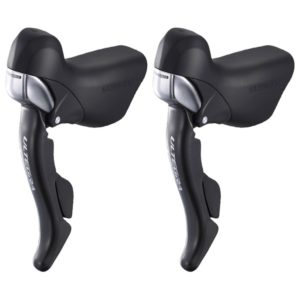
ST-9070 Dura-Ace Road Dual Control Brake Levers/Shifters: The main advantages these have over the ST-6770 version is slightly lighter weight and compatibility with the low-mount sprint shifters. As like the Ultegra version, they are compatible with the climbing shifters. They also have hidden button under the rubber hoods that can activate screen changes on cycling computers from Garmin, Magellan, Pioneer, and Shimano (Shimano SM-EWW01 ANT Wireless Broadcast Module required.)
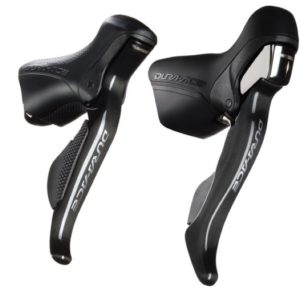
ST-9071 Dura-Ace Time Trial/Triathlon Dual Control Brake Levers/Shifters: These levers provide shifting from the pursuit bar position on time trial bikes. There is no Ultegra option offered at this time. These are available as left/right pairs, or can be ordered separately. These do have a permanently attached wire with a male end for connection the the SM-EW90 front “A” junction. Combined weight both levers: 117 grams.
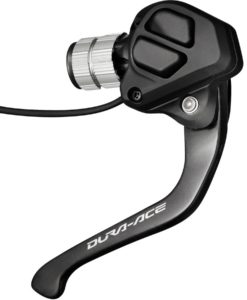
ST-R9160 (standard cable brakes) and ST-R9180 (hydraulic brakes) Time Trial Dual Control Brake Levels/Shifters: These are the lower-profile shifters offered with the newer Dura-Ace R9150 groupset.
ST-6871 Ultegra Time Trial/Triathlon Dual Control Brake Levers/Shifters: Ultegra version of the ST-9071 Dura-Ace shifters. Slightly heavier and much less expensive than the Dura-Ace version. Combined weight both levers: 142 grams.
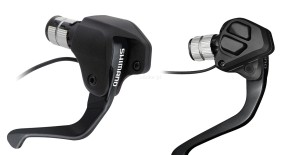
ST-R785 Hydraulic Road Dual Control Brake Levers/Shifters: These hydraulic road shifters are compatible with both the climbing and sprint shifters. These are compatible with the SM-RT99 centerlock 140mm and 160mm rotors and WH-RX31 wheelset (which as no standard rim brake track.) These require the BR-785 dual piston hydraulic disc calipers. They do not have the special wiring port required for the SW-R610 Sprint Shifters and a SM-EW90-B 5-port junction A is required to use the SW-R600 climbing shifter.
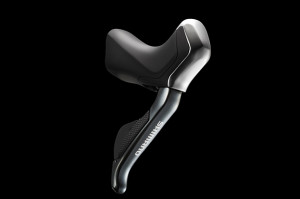
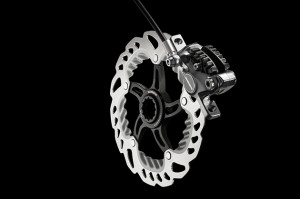
ST-6870 Ultegra Road Dual Control Brake Levers/Shifters: These road shifters are compatible with both the climbing and sprint shifters.
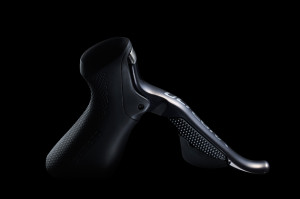
Dedicated Shifters:
SW-R671 Dura-Ace 2-Button Time Trial/Triathlon Bar End Shifters: These shifters are installed on the end of time trial aero bars. By default, the left shifter upshifts/downshifts the front derailleur; the right controls the rear derailleur. For both, the lower button upshifts into a harder gear and the upper button downshifts to an easier gear. This can be changed using the Shimano E-tube Project software; the functions of the left and right sifters can be switched with one another as well. These are available in pairs or separately.
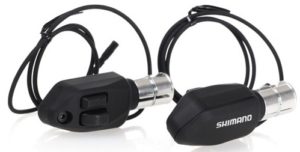
SW-9071 Dura-Ace 1-Button Time Trial/Triathlon Bar End Shifters: These shifters have only one button each and are intended to control only the rear derailleur, with one sending the upshift command and the other the downshift command. (I personally think this version is absolutely worthless. Why have 2 SW-9071 shifters at twice the price and twice the weight, when you can just buy a single SW-R671 Right shifter instead.)
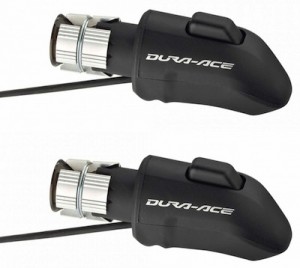
SW-R600 Climbing/PAVE Shifter: This shifter is for road bikes and is mounted on the upper horizontal portion of the handlebar, or any other location comfortable for the rider. They can be used in addition to the Dual Control Brake Lever/Shifter, or can be used on their own by plugging directly into a SM-EW90-A 3-Port Junction or SM-EW90-B Dura-Ace 5-Port Junction.
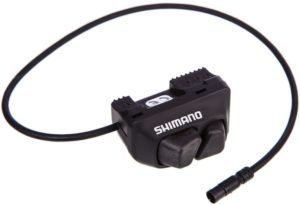
SW-R610 Dura-Ace Sprint Shifter: This is the only component using a unique wiring connector; it is only compatible with the ST-9070 Dura-Ace and Ultegra ST-6870 Road Dual Control Brake Levers/Shifters. Unlike all of the other shifters, the sprint shifters do not contain a circuit board; they do not show up as components on the CAN bus network. Instead, the sprint shifters are simple momentary switches that activate the circuit board on the host Dual Control Brake Lever/Shifter. The host dual control lever is what sends the shift command. (Note: Any momentary switch can be attached to the sprint shifter port on the Dual Control Levers by splicing into a standard EW-SD50 wire to act as remote shifters.)
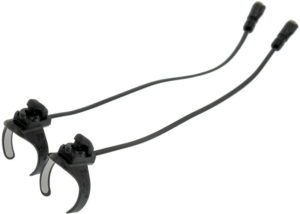
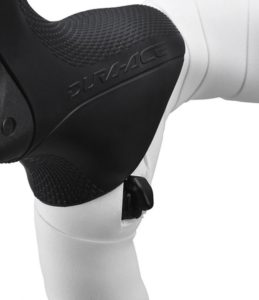
Alfine SW-S705 Right Flat-Bar Shifter: Reported to work with other non-Alfine setups.
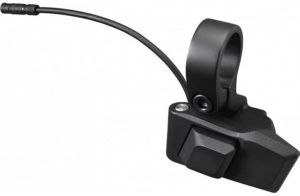
SW-R9160 Time Trial bar-end shifters (pair): These are-end shifters directly control the rear derailleur, with one for the upshfit and one for the downshift. The front derailleur is controlled automatically via automatic Synchronized Shifting. These shifters require the BT-DN110 Internal Battery for synchronized shifting.
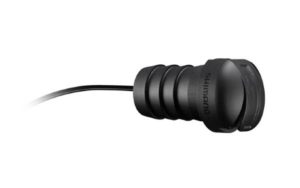
SW-R9150 Climbing shifters (pair): These tiny climbing shifters are about as small as the sprint shifters, but can be directly connected to a junction box and do not have to be connected as slave buttons to a brake/shift lever special port. They come with plastic mounts to make it easier to attach to bars beneath bar tape. They are ideal for synchronized shifting, with one controlling the upshifts and the other downshifts. These shifters require the BT-DN110 Internal Battery for synchronized shifting.
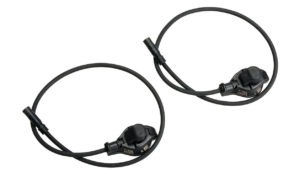

Front Derailleurs:
FD-6770: Ultegra Front Derailleur
FD-6870: Ultegra Front Derailleur, pretty much identical to the FD-6770 but with a slightly larger diameter adjusting screw (to better dissipate the shifting forces).
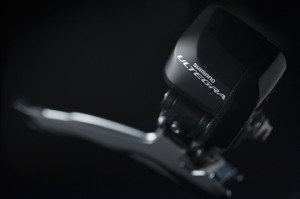
FD-9070: Dura-Ace Front Derailleur
FD-R9150: Dura-Ace Front Derailleur for 9150 systems; features slightly reduced weight vs. 9070.
Rear Derailleurs:
RD-6770: Ultegra 10-Speed Rear Derailleur, compatible with gears up to 28 teeth.
RD-6870: Ultegra 11-Speed Rear Derailleur, compatible with gears up to 32 teeth (for the GS version).
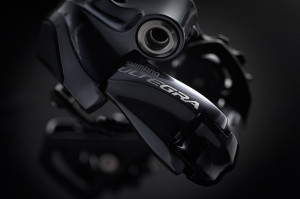
RD-9070: Dura-Ace 11-Speed Rear Derailleur, lighter weight version on which the RD-6870 is based.
RD-R9150: Dura-Ace 11-Speed Rear Derailleur with 30-tooth sprocket compatibility and modified “Shadow RD” geometry to keep the mechanism close to the rear wheel to help avoid damage in the event of an accident.
Alfine SG-S505 and SG-S705: The Shimano series targets comfort and urban bikes. It uses an 8-speed (505) or 11-speed (705) internal epicyclic rear hub. It is believed to be compatible with other Di2 ETube components but this has not been verified.
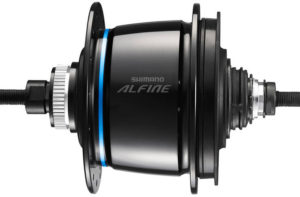
Display / Wireless Communication:
SM-EWW01 ANT Wireless Broadcast Module: This module wirelessly broadcasts Di2 data (front and rear gear selection details, gear ratio, battery life) to a cycling computer using the ANT protocol. It is compatible with Dura-Ace 9070, Ultegra 6870 Di2 and Ultegra 6770 E-tube road shifting systems. SM-EWW01 plugs into the E-tube wiring system between existing components. It has an 2 wiring ports, so it can be connected between a front shifter and the Front Junction A, or at the rear derailleur (between rear derailleur and Etube wire.) It transmits through a proprietary private ANT wireless protocol, which may eventually become a standard public ANT+ protocol. It is powered by the same Di2 system battery. It is currently compatible with the Garmin Edge 1000, Mio 505, and the PRO SCIO cycling computers (with more to come.) The hidden buttons under the hoods of the 9070 shifter levers will switch screens on the cycling computer when paired with this module. It does not currently allow for shifting control from a cycling computer/device and it is not clear that this functionality will ever be offered. The SM-EWW01 is 38mm long, 25mm wide, 12.5mm high, and weighs less than 5 grams. It does not come with any wires; 1 wire would have to be added if adding this module to an existing Di2 system.
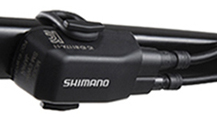
EW-WU101 and EW-WU111 ANT and Bluetooth Wireless Broadcast Modules: These modules are similar to the SM-WEE01 but also include Bluetooth capabilities in addition to ANT capabilities. They require the BT-DN110 battery or the BM-DN100 Battery Mount and cannot be used with the SM-EW67 Front A Junction.
SC705 Alfine Display Unit: This unit displays the battery level and the rear derailleur gear selection. It is powered by the system battery and has a port for the SM-BCR2 internal battery charger / USB diagnostic tool. It is primarily designed for Alfine systems (both 8 505-series and 11 speed 705-series). It is compatible with Ultegra and Dura-Ace Di2.
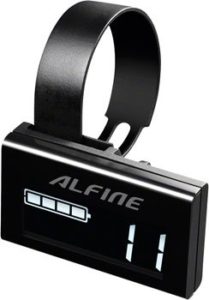
MT800 Digital Display with Bluetooth: Primarily aimed at XT mountain bike applications, this display allows toggling between the 3 synchronized shift modes (where both derailleurs are intelligently coordinated in unison by one pair of buttons, so no need for discrete shifting of the front derailleur.) It also shows battery level, gear position, shift mode and FOX iRD suspension position. The Digital Display required the new BT-DN110 battery. Existing Di2 XT systems are upgradable to be compatible with the new digital display after battery upgrade and firmware upgrade. This display has 3-port Di2 Cable junction and charging port integrated into the back and serves as a Front A Junction.
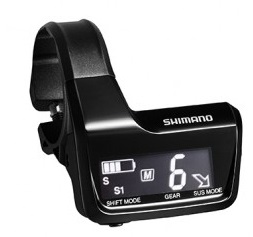
Batteries and Battery Mounts:
The batteries contain the main controllers for the system. It is therefore required to upgrade the battery to get features released in new versions of Di2 (such as Synchronized Shifting that automatically controls the front derailleur based on rear derailleur shifting.)
SM-BTR1 External Battery: This external battery must be used with the SM-BMR1 battery mount. It is removed from the mount and charged using a dedicated charger.
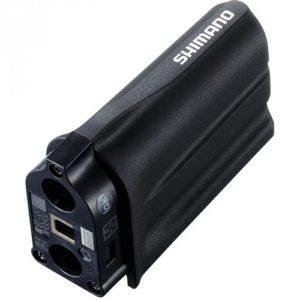
SM-BMR1 and SM-BMR2 External Battery Mount: This mount attached to bottle cage mount points or other dedicated frame mounts. It is available in 3 different mount lengths: -I (intermediate length), -S (short length), -L (long length). The SM-BMR2 is an updated version of the SM-BMR1.
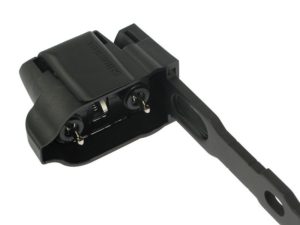
SM-BTR2 Internal Battery: This battery is typically mounted in the seat post or seat tube of the frame. It is charged by plugging the SM-BCR2 Charging Cable/PC Adapter into the SM-EW90-A or SM-EW90-B Front A junctions.
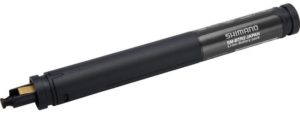
BT-DN110 Internal Battery: This battery is required for Bluetooth wireless units and road groupset Synchronized Shifting functionality.
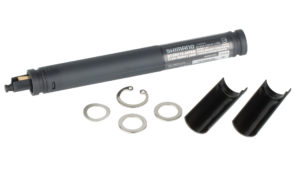
BM-DN100 External Battery Mount: This battery is required for Bluetooth wireless units and road groupset Synchronized Shifting functionality.
Front A Junctions:
SM-EW67-A-E Ultegra 3-Cable Junction: This is the original front junction with 2 integrated cables to connect to the dual control brake lever/shifters. The male cable ends on this Front A Junction will not mate directly to the male cable ends on any of the Time Trial/Triathlon dual control brake shift levers or shifters; SM-JC41 Rear B Junctions can be used to connect this front A junction to TT/Triathlon shifters. This Junction works only with External Batteries, not Internal Batteries.
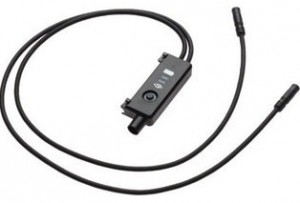
SM-EW90-A Dura-Ace 3-Port Junction: This front “A” junction is most commonly used in road bike setups. 2 ports connect to the dual control brake / shift levers; the third port is for the cable that leads to the bottom bracket junction.
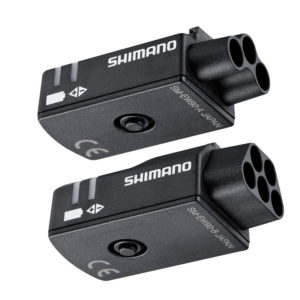

SM-EW90-B Dura-Ace 5-Port Junction: This front “A” junction is primarily used in the Time Trial / Triathlon setups. 2 of the port are for the brake/shifter dual control levers, 2 of the ports are for the aer0 bar bar-end shifters, and the 5th port is for the cable that runs to the bottom bracket (where the B junction joins the wires from the front A junction, front derailleur, rear derailleur, and battery.)
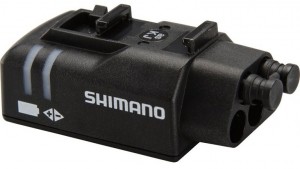
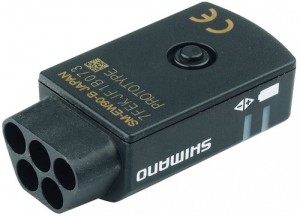
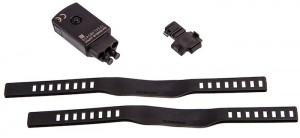
EW-RS910 Internal Bar-end Junction: This junction is installed into the end of a bar or in a dedicated frame port. It facilitates internal cable routing.
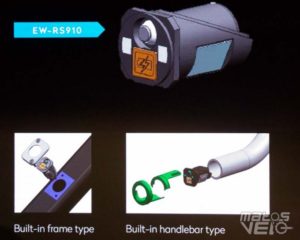
B Junctions:
SM-JC41 Internal Junction: This version has the exact functionality as the SM-JC40 external version, but doesn’t have the mounting tab for being bolted to the bottom bracket or wrapping the extra cable lengths. It has 2 ports on one end and 2 on the other, making it more compact. In addition to being located at the bottom bracket to connect the A junction, battery, front derailleur, and rear derailleur, it can be used at the handle bars to join multiple shifters prior to being connected to the A Junction.
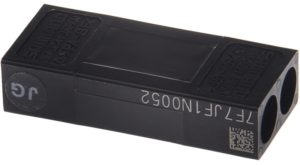
SM-JC40 External Junction: This version is intended to be attached to the frame using the bolt that is commonly located underneath the bottom bracket housing. This junction contains no electronics; it’s sole purpose is to join 4 connectors together, which are usually the wire from the front A junction, the battery, the front derailleur, and the rear derailleur. There are wire holders above the housing to capture the extra wire length by wrapping it back-and-forth.
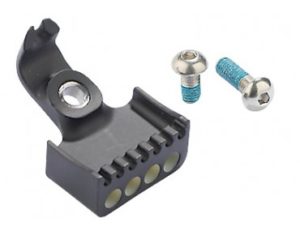
Cables, Grommets, and Cable Remove/Install Tool:
EW-SD50 Cables: These cables connect the front A junction, the battery, the front derailleur, and the rear derailleur to the rear B junction, which is typically located near the bottom bracket (near the cranks.) These are available in lengths of 300mm, 350mm, 400mm, 500mm, 550mm, 600mm, 700mm, 750mm, 950mm, 1000mm, 1200mm, 1400mm.
SM-GM01 Grommet: These round grommets are used when drilling round holes for internal cable routing, or with existing round holes. The required hole diameter is 6mm (6mm = .236 inches. Use a 7/32-inch drill bit and then “wallow-out” the hole to make it a little bigger; a 1/4-inch drill bit will work but is just slightly larger than necessary.)
SM-GM02 Grommet: These 7mm x 8mm oval shape grommets are used in some situations / frame designs.
Shimano TL-EW02 Ultegra DI2 E-Tube Tool: This tool is used to connect and disconnect the Etube wires. They are extremely difficult to connect/disconnect by hand, and pliers or other tools can damage the wires. Don’t get this confused with the TL-EW01 tool, which is for the older 5-wire 7970 cables. (My Dura-Ace TT Dual Control Levers came with one of these tools, but no other components did.)
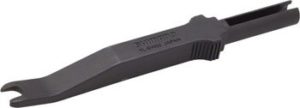
Common Questions (via Shimano):
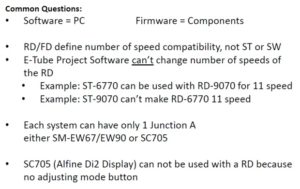
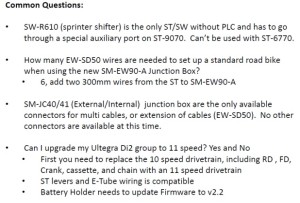
Note: it is not necessary to replace the FD from upgrading from 10-speed to 11-speed.
What Components do I need to put together my own Di2 system?
Because of the huge number and variety of components, it’s very difficult to figure out what is actually necessary and what is optional. So here is a list, for the setup I recommend: Ultegra 6870. It starts from the handlebars and works backwards. (This assumes both front and rear derailleurs, but you actually don’t have to have both; you can pick one or the other and only the corresponding front shifter to go along with it.)
- Any Type of Shifters / Shift Buttons. The Dual Control Brake Levers/Shifters are not required. You can get the just the climbing shifters or Triathlon/TT bar-end shifters, and then potentially add the Dual Control Levers/Shifters at a later point. (The only exception is the Sprint shifters, which require specific Dual Control Levers/Shifters with special ports as noted elsewhere in this article.) Amazon.com link
- EW-SD50 Wires 1 and 2 between the front shifters and the Front Junction A (0nly for some shifters). This is a bit confusing, because some of the front shifters come with wiring attached to them and some of them require purchasing separate wires. In general, most of the stand-alone shifters come with wiring, as do the TT/Triathlon dual control shifters/levers, but the road dual control levers do not. Amazon.com link
- Front Junction A. I recommend the SM-EW90-B 5-port front junction A as it provides the most upgrade flexibility; get the 3-port option only if you’re positive you’re never going to add more shifting components. The older SM-EW67-A-E has 2 wires built-in to connect with each of the dual control shift/brake levers; it doesn’t offer much flexibility or compatibility with a TT/Triathlon setup or adding additional shifters. Amazon.com link
- EW-SD50 Wire 3 between the Front Junction A and the 4-port Rear Junction B connector. Amazon.com link
- EW-SD50 Wire 4 between the Rear Junction B and the Front Derailleur. Amazon.com link
- EW-SD50 Wire 5 between the Rear Junction B and the Battery. Amazon.com link
- EW-SD50 Wire 6 between the Rear Junction B and the Rear Derailleur. Amazon.com link
- Rear Junction B: This is where the wire from the front of the bike is connected to 3 output wires leading to the front derailleur, rear derailleur, and battery. SM-JC40 is for external wiring, SM-JC41 is for internal. Amazon.com link
- Grommets for any place where the wire goes into the frame through a drilled hole. Amazon.com link
- Front Derailleur. I recommend the Ultegra FD-6870 for 11-speed builds or the FD-6770 for 10-speed builds. The Dura-Ace FD-9070 is pretty much identical, just slightly (41g) lighter and 11-speed only. (I do not recommend the Ultegra FD-6770 unless you have a 10-speed setup, because of firmware compatibility issues with 11-speed rear derailleurs. Also, it is an older design than the FD-6870, so it is larger and offers slightly less shifting force.) Amazon.com link
- Battery and Charger. Internal or external, depending on the build. If you have to skill/time/money-to-pay-someone to get everything internal, I highly recommend that option. The SM-BTR2 internal battery has more advanced integrated electronics and is better for firmware upgrades with the SM-BCR2 internal battery charger/PC tool. If you go with the SM-BTR1 external battery, you will need the SM-BMR1 external battery mount and SM-BCR1 external battery charger. Amazon.com link
- Rear Derailleur. I recommend the Ultegra RD-6870 for a new build if you have 11-speed compatible wheels with 11-speed sprockets, or the Ultegra RD-6770 if you have 10-speed wheels/sprockets. The system must be match front and rear derailleurs (both 6870 11-speed or both 6770 10-speed.) Amazon.com link
- TL-EW02 Etube Wire Remove/Install Tool: It takes quite a bit of force to snap the wires in/out. You may think you can get it seated properly with just your fingers, only to then have the wire come loose because it wasn’t fully seated. It’s a good idea to keep one in your saddle bag. Amazon.com link
What wire lengths do I need? This question is impossible to answer correctly, as it’s highly dependent on the frame size and configuration. What I recommend is running string between the component mounting locations to measure the lengths. Be sure to add some extra length, as I find that wires seem to come up short pretty frequently, even when “adding a little extra” to start with. Nothing is more frustrating that having a wire that is 25mm too short. I recommend ordering a few extra wires of multiple lengths and then returning the unneeded/unused wires. As noted above, the standard wire lengths are 300mm, 350mm, 400mm, 500mm, 550mm, 600mm, 700mm, 750mm, 950mm, 1000mm, 1200mm, 1400mm. Do not cut/splice these wires; the connectors on the end of the wires are very small in diameter to start with and you’ll end up with a splice that is larger and less waterproof than you started with.
Acknowledgements: Special thanks to Di2diy for his continued help in the comments. Check out his Ebay store for custom Di2 batteries, harnesses, and components.
Technical Details of the Di2 CANBUS protocol and signaling
Thanks to commenter Ghislain for the details: “I reversed engineered the signal going to the RD. Since I did not have a special tap connector, I could only look at the actual signals in open loop (RD wire disconnected) on the wire going to the RD using an oscilloscope. First, I found that shift up and down are multiplexed on the same wire. A shift down would generate a positive 100 msec clean 8 volt pulse (varies between 50 msec to 500 msec depending on how long you hold the shifter). On the same wire, a shift up would generate a series of 2 msec pulses that would last the same time of a shift down pulse. Therefore, the RD has enough intelligence to discriminate between the 2 types of pulses. When you hold the button on junction A, a 140 msec pulse is generated. But since my RD wire was disconnected, the RD would not go in adjust mode.”
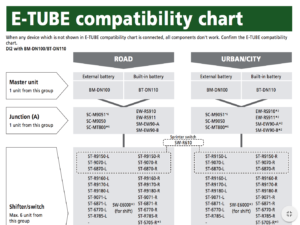
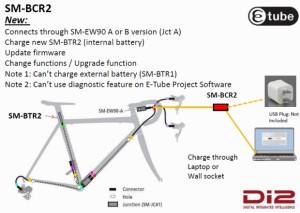
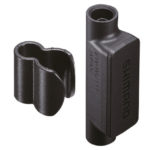
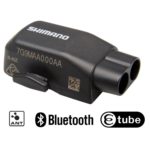
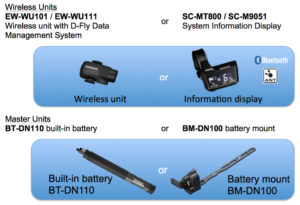
Hi Carlton
How do I rotate the SW-R671 Di2 2×10/11-speed Remote 2 button shifters
Can I replace my rear derailleur (9070)di2 with the latest type dura ace one I’m trying to fitt 30t cassette and can’t on present system
Yes, but why not opt for the Ultegra RD? That will give you the option of 34t AND save you $.
Wasn’t sure if these were fully compatible had actually thought a bought it .OK thanks for the advice I’m on it ..
@Liam Buckley …above comment now several months past….same question pretty much…Have you gone down this road with the Ultegra RD and if so what feedback? I’m considering the DuraAce rd9150 for the same reasons. I have been able to configure my existing fd9070 to work with an 11-30t set but cannot get my E-Tube (3.3.3) to recognize this as a vaild configuration. Since the 9150 now retails (in Germany) at almost €500 it’s a serious consideration. Finally @Carlton am I correct in assuming that anything that is listed as a valid configuration in the E-Tube compatibility charts will work…meaning just swapping out the rear derailleur without having to also change the shifters. In summary will ST-9070L/R work with RD-R9150 without problem…
Hi , is using SM-BTC1 + BTR2 compatible with R8050 ?
does using SM-BTC1 eliminate the need for junction B in this case ?
Yes.
Check it out here: http://si.shimano.com/pdfs/dm/DM-M8050-06-ENG.pdf
Hi Carlton
I have a C-dale Synapse with ST-R785 Di2 levers (the first iteration of Shimano’s di2 hydraulic lever)
i would like to be able to add some TT extensions with the TT Di2 shifters on the ends.
Can I swap my 3 port junction for a 5 port junction box and add the shifters in?
thanks
Nathan
Hi Carlton. I keep getting a dead Di2… I cycle somewhere then leave the bike for a coffee for a bit then when I get back to the bike the gears are dead. I have to unplug the battery to reset. I wondered if this was due to heat – I think it happens when the bike is left on a hot day …. any thoughts would be much appreciated!
a bit more on this – this morning I put my bike in direct sunlight and left it for 30 minutes – gears were working before trying this. Then after 30 minutes the gears were dead. I was thinking this might be the Bluetooth module so removed that, waited for the bike to cool down and the gears to work again and then left the bike in the sun again. Gears dead again.
I plugged the bike into my laptop and got etube running which showed that the shifters weren’t recognised but everything else was. Have you ever come across a problem like this? Seems to be related to heat and the connections from the and including the junction box to the shifters…
DI2 – R9170 components throughout. Any thoughts?
Great troubleshooting! This is very odd. All of the components should work fine at common temperatures. It’s unlikely that both shifters are not working properly at the same time. So it’s more likely a cable or an A-junction. I would get an extra Etube cable and start disconnecting components/cables and connecting them directly with an external cable to isolate the bad component.
I had a problem some months ago, but put it down to cold. I always left my battery go down to flashing red. Used the same charger (Mar 2015) to charge up. Same garage and around the same yearly temperatures. This spring I went out, indicator was flashing green. 30km into a 65km cycle, front derailluer went to small chain ring. Charged up once home. Within two or three weeks, the same thing happened again. I had a new cable cut in half and four 4mm multi meter test sockets inline. I checked the voltage drop each day at around the same time for about two weeks. Each day it dropped around 0.07 Volts. I remember I was ok on the bike on Good Friday, a 130km cycle with a few front derailluer shifts and the drop for that ride was only 0.03 Volts. I also checked each derailluer movement loading and using a Fluke ma grip on clamp meter, got around 9mA per shift. I thought the front derailluer would be more as that is the one that would remove your finger from your hand. I then removed the seat post and got the same results, 0.07Volt drop per day……New battery required. I changed my charger and have no problem since. I always charge now on flashing green. I have always been care full where I park the bike and watch where the buttons are resting….. One final point, I always park up on the small chain ring.Why, just in case the system thinks the voltage is low and wants to change down, I don’t want it happening in my garage and the chain pulling across the chain ring for a few days. I have more info, but traveling at the moment. I can send it on in excel/ Word doc.
Small question , about Full syncro mode , it allows automatic control of FD when i move up or down the cassette , but does it also allows auto. control of RD when i move between crank rings “like in semi-syncro mode”
Hi,
just bought a frame with Di-2 pre-installed.
Brand new R8050 mechs now fitted =by me during assembly.
I have not had an opportunity to view the set up on the Ipad, but I notice that the rear mech is working 11 speeds whilst on the small ring, but only 9 when on the big ring.
The previous frame owner (semi-pro triathlete) had not set up Synchro (I have tried double/triple clicking the A-Junction)
Has anyone seen this operation before ??
Morning Stephen
On my bike it is the other way around, namely, when in the small chainring the RD will not shift onto the two smallest cassette sprockets. According to the Shimano Dealer Manual this is deliberate and part of normal operation, presumably to avoid extreme chain angles. I have not set up syncro or semi syncro shifting but have my system on M (manual mode so I’m using both shifters)
Thanks for the reply. The avoidance of extreme chain angles makes sense, and the risk of the chain jumping onto the big ring without warning.
I will have a closer look into this on this bike and my other bike which has 6870 fitted (with Synchro).
I certainly note that my Synchro (rear) works it’s way through the ratios so that there are effectively only 16 gears in use. It does still allow me to force the front mech across.
Hi Stephen I too have 6850 on another bike but that limiting feature was not present – I think it is a new feature to the R8000 series, maybe because the RD cage is brought slightly inboard. The only other difference which may have a bearing is that my 6850 has a short cage whereas my R8050 has a medium cage
Hi Carlton,
Sorry in advance for this long-winded post but I need some help with my Ultegra Di2 RD 6870. I washed the bike after a particularly dusty ride a few weeks ago and since then my RD has stopped working. Ive tried a whole bunch of things:
1.) Initially, i thought it was water damage, so i left it to dry in the sun…nope.
2.) Then i thought maybe i should connect it to e-tube and see whats up: everything (including the gear position unit near the RD) gets recognised, but it cant find the RD.
3.) I noticed my battery was also dying every 2 days or so, so i took out the battery and put a spare one on. Same result…so its not the battery.
4.) I turned my attention next to the cables and junction box near the BB…thinking that maybe some water got pooled in the JB terminals and caused a shortage. So i took out my BB and played around with the JB swapping the cables. Again, RD doesnt work but all the JB terminals do.
5.) RD cable. Next i connected my RD to the cable entering the FD, because the FD works fine. No dice. RD still doesnt work, so its not the cables.
6.) Crash mode. Here’s one thing i’ve not been able to try. I noticed that when I press the button on my control box SM-EW90 junction, i cant get it to turn on calibration mode (solid red light). However, when i press the buttons on the shifter to check battery level, i can get the green and red lights showing the correct battery status. I havent been able to figure this out…the button on the JB essentially doesnt do anything. I hadnt needed calibration mode before this hiccup so i dont know if the button has always been faulty or it happened because of the wash.
Even if it entered crash mode, i thought the RD would shift to the easiest gear automatically? Right now its stuck dead 3 gears from the easiest.
7) Last, i havent been able to check the voltages heading to the derailleur or out of the battery. As soon as I connect the RD, the battery dies within 2 days, otherwise, it stays solid green after charging. Do you think this is the next step to take?
I dont have a SM-PCE1 tool to directly connect the RD to e-tube, but with a normal e-tube connection via SM-EW90, i can see all the components except the RD…so I know the EW90 is also working fine! Unfortunately, im in a place where there are no LBS’s nearby that can diagnose or look at Di2 components, so im on my own here.
Help! I didnt expect the RD to be dead after a few mins of water spraying when i’ve ridden through much worse conditions on the road!!
Sorry for the double post.
I have had this issue and here is my tuppence worth.
Diagnosis via the PCE1 is the best way to go, almost always, though even that can lead you astray if your battery is not adequately charged.
For example, if your battery is not adequately charged the PCE1 can simply list that the system will not work without certain components, even if they are all present and correct.
I recovered from a similar scenario to yours by simply making sure the battery was fully charged before moving forward. I used two batteries and both needed topped up! Yep, silly, but that was it.
If fully charged batteries fail to resolve the issue, [assuming you are not simply following procedures to exit emergency/crash mode] then you want to PCE1 diagnose your RD [directly] and check all is up to date and error free.
Enjoy Di2. We love it!
Thanks James. Unfortunately, i’ve also tried that. I’ve charged the batteries for 8-12 hours at a time (more than their recommended 2-4 hrs) because everytime i connect the RD, the battery dies within a day…without the RD, it keeps going without problems. I’ll try it again anyway…thanks.
I have had this issue and here is my tuppence worth.
Diagnosis via the PCE1 is the best way to go, almost alway, though even that can lead you astray if your is not battery adequately charged.
For example, if your battery is not adequately charged the PCE1 can simply list that the system will not work without certain components, even if they are all present and correct.
I recovered from a similar scenario to yours by simply, making sure the battery was fully charged before moving forward. I used two batteries and both needed topped up!
If fully charged batteries fail to resolve the issue, [assuming you are not simply following procedures to exit emergency mode] then you want to PCE1 diagnose your RD [directly] and check all is up to date and error free.
Enjoy Di2. We love it!
I have a Dura Ace dI2 and the rear derailleur has stopped working. I recall there was a clicking noise before it stopped. I have replaced the external battery but this hasn’t helped. I have swapped rear and front mech cables and the rear shifter will work the front derailleur. The rear derailleur will automatically shift in protection mode but then will not work with the shifters. Any further ideas would be much appreciated.
Thanks
Marcus
Your best bet is to use the PCE1 computer tool for full diagnostics. Short of that, it seems like you have a failed rear derailleur. So you can either use the PCE1 to do a full diagnostic, or get a new rear derailleur.
It sounds like you have a failed rear derailleur. If it has the same problems when connected via a different wire (i.e. the front derailleur wire), then you can rule out cables and assume it’s the derailleur that is failed. You can probably confirm via the PCE1, or you can get a new rear derailleur and see if that fixes it.
So to adjust the auto trim on the front derailleur when in the 6th gear you enter adjustment mode on the big\big then move to the small ring and 6th on the rear and make the trim adjustments? Is that how it works as I’m having a slight rub on outer edge of FD.
Hi all, just a quick question, has this happen to anyone before. My external battery support suddenly stopped working. Below I describe what happened.
I have had DI2 for ages, with no real problems. I have be racing and training with for the past 3 years (55,000km+) in this set up 10sp front derailluer with a 11sp rear derailluer and I have not had a single problem as I have never bothered doing any updates(as I know about the bug issue). But last weekend in a race a guy crashed into me breaking my rear derailluer. So I bought the same 11sp derailluer again. I fitted to the bike and it all worked fine for about 5mins, then I put it in to the adjustment mode and then all of a sudden the bike just shut down. Nothing at all, no lights, no front or rear derailluer working. So I connected the SM-PCE1 and it found all the items (it obviously comes up that the front and rear derailluer are not compatible- but we know this not to be true). The only thing it did not find is the external battery support. So I tried connecting this direct still it was not showing it was connected. So it is possible that the new derailluer can send a bug to stop the battery support working. If so how? And if I buy a new battery support and new front derailluer will it work?
Many thanks for any help with this matter.
Hi
I have what I thought was a simple problem, but can’t find answers anywhere.
I have a Di2 system with BT-DN110 battery and D-fly EW-WU111. It works fine with synchro shifting and all and deliveres info to my Garmin 1000 on which gear combination I’m in. Now I have changed the rear cassette from 11-28 to 11-30 but it still displays gear combinations on my Garmin as if I had 11-28. I can change the gear numbers on the Garmin to 11-30 but after a few seconds the D-fly overwrites it back to 11-28. In the E-tube program I don’t get the 11-30 option – only 11-25, 11-28, 12-25, 12-28, 11-23, 14-28. I guess it doesn’t have any impact on the actual shifting – seems to work fine, but it annoys me to get a wrong gear number reading on the Garmin.
Thank you in advance.
You have told E-Tube that you are using a RD-6870 SS rear mech. You need to change this to the GS version. This will then give you the 11-30 option.
Hi Stephen
Thanks for your quick reply. My rear derailleur is a RD-9070 SS and E-tube recognizes it automatically. When I try to change it to 6870 GS I can see options which ao. gives 11-30, but when trying to save it says: “unable to recognize unit RD-6870-GS.
That is because Shimano don’t think the short cage RD works with a 30 tooth sprocket! 🙂
But it does So I just have to live with the wrong info on the Garmin? Seems too expensive to buy a new derailleur just to get the right reading on the Garmin
Thank you. I am very impressed by your quick response and looking forward to following the blog in the future.
So glad for your page. Using almost exclusively the information here, I upgraded my tt to di2 and haven’t looked back. Now I’m getting ready to build a new bike up over the course of the next year, and was planning to do dura ace di2, but after finding out that the bar end shifters for DA are single control and everything relies on synchro shifting, I’m having second thoughts. I’d love to know what you think about it – you know how we humans are about change. I’m okay doing an ultegra build – just finally was at a point in my life where DA was an option if I build slow. And I’m just not sure how I feel about ONLY having the option of the synchro shifting. Thanks in advance
For Ultegra vs. Dura-Ace, that’s more of a personal and financial decision. The two are extremely similar.
For SyncroShift and the number of buttons on the bar-end shifters, that’s a separate decision from Ultegra vs. Dura-Ace. All shifters are compatible with all derailleurs. For me, given that the pricing is about the same, it would definitely get 2 of the 2-button shifters instead of 2 of the 1-button shifters. If you want to go pure SyncroShift control, just use the rear derailleur shifter or program both to be rear derailleur shifters. If you decide you want front derailleur control occasionally, then use the second shifter only when you need it. And if you decide you hate SyncroShift, you can turn it off completely using the PC or Smartphone software and still have all the buttons you need.
I do not like the single button bar-end shifters. If I only wanted 2 buttons for exclusive SyncoShift, then I would order a single 2-button shifter and use a bar plug in the other location. This would save both cost and weight.
I have a 2015 bike with 6870 DI2. I see a Dura ace RD9150 SS for sale. Is this work with mu DI2 system and will the cable connect ok.
Yes
Fantastic post and really helpfull, thanks alot. One question, do you know if you can connect two right hand levers to one di2 setup, den reprogram one of them to serve as a left lever? I don’t care about mounting the acctual levers I just need the electronics inside for a DIY TT setup. I theory this could work, since you can program the levers to do pretty much whatever, but my concern is that the whole system might protest when there is two right levers connected?
You should be able to use 2 right levers at the same time. You would need to connect them individually when configuring them with the Etube software, but after initial configuration, they should both work on the same bike at the same time. I haven’t tried this myself, but have seen it mentioned by others. Please let us know how it goes.
Managed to lose the wireless / Wifi signal whilst updating the firmware to my DN100 battery holder, so effectively “bricked it” (as I believe the term). Tried updating again but no joy after 2 hours.
I have dropped the DN100 off at the local bike shop as they have the SM-PCE1 and should be able to do the firmware by hard wire.
NOW………since I have a MAC computer, is there any point buying a PCE1 ?? Have Shimano come out with E-Tube for Mac yet ??? (I suppose I could “borrow” a Windows PC from the kids)
Would I actually NEED a PCE1 ??? I do have a SM-BCR2 charger as well. Could I use that instead ??
I installed Windows via Bootcamp on my Mac to address those “hardware utilities only works with Windows” scenarios.
You probably could have recovered the battery using the SM-BCR2 on a Windows computer. In E-tube for Windows, there is a separate icon that shows just a wire symbol. It is on the far right of the screen. You select the type of bike you are connecting to, then pick a device-type (i.e. battery) and manually apply the firmware update. (The PC cable must be connected to just that one device.)
I took the DN100 to my local bike shop and they hooked it up to a PCE1 and sorted it.
I was considering buying my own PCE1…..but then remembered I don’t have a Windows computer !! (Just Apple)
Hi Carlton, I have a TT setup with single bar end shifters set up by dealer. On first ride I found the synchro shift doesn’t work and I’m stick in big ring. All components register on E tube and synchro shift is selected and FD will micro adjust with rear cassette chain movement but chain won’t move to small ring as it’s supposed to. Bike shop say bring it back for analysis but that’s a days drive away. Any assistance would be much appreciated. Thanks
I’m wondering if the gearing needs to be configured in etube. That has to be done so the appropriate gear ratio transitions occur. I haven’t had to do that, so I don’t have details…
I suspect that you need to tell E-tube what gearing you are using, and also when you want the shifting of the front to occur.
You do also need to ensure that you have synchro assigned to at least one of the modes of the A-Junction. (It will not do synhcro mode if it is not in Synchro !!).
Another option you can do is to fit and hide a SW-R600 climbing shifter which can operate the front mech. Quite handy to have this if you are facing a hill climb and you know you need the granny-ring !!
I have a 2015 Focus Cayo 2.0. It has 6870 DI2 groupset on it. If in the future I need to replace parts, can I use a R8050 rear derailleur instead of the 6870, the same with the front derailleur. The main part that I might want to change is the front crankset, I know the R8000 has about 0.4mm less difference between both chain rings. can this work ok with my FD-6870 front derailleur ?
As long as the derailleurs have the same number of speeds/gears, they should be compatible. I don’t think you need to replace your front derailleur to switch the front crankset. There’s plenty of adjust-ability and 0.4 mm is negligable and could easily be accounted for in trim settings. The only reason to switch rear derailleurs is to go from 10-sprockets to 11-sprockets, or from a shorter cage to a longer cage to accommodate larger rear sprockets.
The reason I would be changing the rear derailluer, would be if it stopped working or was damaged, then it would be, get an 6870 or the newer 8050 which may be more easier available at that time.
Hi C
I have some different parts home since earlier and try to get a set working for one of the bikes in the for the family and it seem to be working but I do not have an extra charger for a SM-BTR1 battery (BCR1) but I have one BCR2 and the the bike do have a EW90 connector will this work with a BMRx or DN100?
(This bike (owner also) will most likely move from home and need to possibility to charge)
The charger for the internal battery will not charge the external battery, if that is what you are asking. The charger port on the 5-port Junction A only works on the internal battery.
I would like to confirm a few things before trying to update a system with an external battery.
1. The bike has the 5 port A junction – not the old style with integral cables. Nothing to change.
2. The original battery mount needs to be replaced with a BM-DN100.
3. The part that isn’t totally clear, some web sites indicate the “brains” are in the battery. Yet the Shimano compatibility page indicates the current external battery is the SM-BTR1. Will my SM-BTR1 from 2015 work?
4. From the Shimano compatibility page there appears to be two Ant/Bluetooth transmitters: EW-WU101 and EW-WU111. Are there any functionality differences?
5. Is there any reason other than not having an external battery to change to an internal battery?
From what I recall about the external battery, the “brains” are in the battery mount, not the battery. For the internal battery, they are in the battery. So your external battery should work in in the new mount.
From what I can tell, EW-WU101 and EW-WU111 are functionally the same.
The reason for the internal battery vs. external is mostly aesthetics, and perhaps a tiny bit more water protection.
Any chance you can update the download link for E-tube_Proj_V_2_5_2.exe? Thanks!
I updated the download link to https://carltonbale.com/wp-content/uploads/E-tube_Proj_V_2_5_2.zip
Thanks so much!
Hi,
Can the new bar end shifters SW-R9160 be used on a 6870 road setup (with the old internal battery from 2016, no synchro shift), connecting them directly to a SM-EW90-B junction (the one with 5 connectors) to shift the rear derailleur, just like the SW-9071 shifters?
I’ve read that they’re only compatible with the 9050 road STI, and you also refer they that “These shifters require the BT-DN110 Internal Battery for synchronized shifting.”, but what if I want to use them just as normal shifters, like the SW-9071, one goes up the cassete, the other goes down. Nt possible?
Thanks for your help!
RP
They should be compatible as long as everything has the latest firmware. They use the standard shit commands.
I did that combo on my Madone 9. It works flawlessly.
Thank you both for your answers!
Hi, Thanks in advance for all your help. I’m still a little confused.
I am currently running a bike with all the original old 6770 components, with the external battery, and the old SM-EW67 junction box, and everything is still working perfectly.
I recently purchased the new R8050 FD and RD and an 11 speed cassette. I stupidly thought everything would be plug and play as i was replacing both FD and RD together, but when I did this, nothing worked.
So I went to the local bike shop here (Chiang Mai) and he was able to update the software to the latest version, (the software had never been upgraded on the bike since purchasing it) but he said in order for the RD and RD to work, I will need to replace the front junction box also? Is this info correct? And therefore I will need two extra connecting wires to connect the new SM-EW90-A? Will my new shiny R8050 FD and RD work then?
Thanks again!
That is correct. The old junction does not work with newer components.
I use a 6770 Front Derailleur with an 11 Sped RD 6870 and the EW67A Junction – that work flawless – subject to the condition the you downgrade the firmware.
Hey JurIJ, Do you have an internal or external battery? Thanks!
I am running an external battery
I have 6870. I see where I can pick up a spare set of levers, I was thinking of getting them as I have worn the coating off the levers and If I see or drop it , I would be ready to go. The other idea is wait and fit a set of the 8050. Will this work and I see they have hidden buttons under the hoods, what are these for ?
Is there any reason I can’t use a JC-40 (external) junction B as an internal junction B.
I have a new Focus Paralane Di2 and I added the EW-WU111 BT module. Downloaded the E-Tube app to my phone. It all hooks up and recognizes all the components. Updated all firm ware ok. The problem is that the system shows the standard cage SS rear derailleur when I have the long cage GS model, so the rear cluster choices do not include my 11/34 rear cluster. Any idea how to correct this?
Steven,
Sorry to hear about your issue. I haven’t run into this issue before. My best guess is that it’s an app issue. The Etube windows software may correctly recognize the derailleir and it’s capabilities. I would try that, or submit a big report to Shimano and wait…
Thanks for your reply. After looking at the rear cassette closer I found that Focus installed an 11/30 and not the advertised 11/34. So they used the SS mid cage rear derailleur as a result. This bike was brand new in the factory sealed box, so it was apparently a production change for whatever reason.
Perhaps yours is actually the short cage model…and a previous owner has fitted the long cage to it ??
A friend of mine bought a S-works Tarmac second hand, great bike but geared for a pro. He has short body so if I change the front crankset from 53/39 to 52/36, will the Dura ace 9070 di2 front derailleur still do with the smaller rings. if I want to put a large range cassette in the back(CS-R8000, 11/30 or 11/32) can I put a 6870 med cage on the Dura ace RD or chamge the rear derailleur to a 6870 or a newer R8050 with the longer cage?
All of the 11-speed compatible derailleurs are interchangeable. You just can’t use older 10-speed versions.
The front mech will have no problems with a 52/36 or even a 50/34, the same mech does them all, you may need to adjust the position on the seat tube of the mech if its a long way out, the bottom of the mech should be just clear of the teeth, you can make your own guide from your present set up!
Has anyone put a GS cage on a RD-9070 from a ultegra 6870?
Just setting up a 6870 system with a BTR2 but am getting no connection . I have a green light at the junction a that indicates 100% power but no transfer to the derailleurs? Something simple I hope.
Just fitted a FC-R8000 34/50 crankset where a S- works crankset was on a BB30. I fitted in two BB30 to 24mm adaptors. The DI2 sysltem is 9070. All looks fine, but I would have liked more inward movement on the front derailluer cage. In the small ring and big cassette, I just gotabout 0.5mm and when out on the big ring, the crank arm seems to be close enough to the derailluer as it passes through. When I was setting it up, I could not get the movements asked for using the feeler gauge. I could try to take a skim off the drive side adaptor to move the crank inward slightly.
Slight brain fade this morning. If I can not get the front derailleur to move inward more, I might get a thin washer/spacer to mover the crankset out further (0.5 to 1mm).
Set the front mech as per the instructions – find Shimano TechDocs online. You want the DM-UL0001-04-ENG document.
Once you have physically set the front mech, carry out a front mech “TRIM” .
Plenty of sellers online with “Shim Washer”. you will want 24 – 25mm internal diameter and thicknesses around 0.3mm.
TT bike has been losing its charge for some time now so thought now is the time to finally address this issue. I can charge it up and then within a few days the battery is flat. What is the best way to find out why its not holding charge?
Thanks
Hey there. I have a 2014 ultegra di2 6770 original set up that I’d like to upgrade to work wirelessly with my iPhone and take advantage of the newer features with my Garmin edge 520. I was given a EW-WU101 for Christmas but I understand from reading this that it won’t work unless I upgrade some other components (including the firmware). What do I need to upgrade/replace from my original di2 in order to get the wireless capability working? Thanks.
Leigh, you will need a new internal battery and will need to update the firmware of everything using the Windows eTools software. You will then be able connect and configure via the mobile app over Bluetooth. I recommend setting up a Bluetooth pairing PIN code in eTools; this will help prevent others from connecting to your bike Bluetooth and reconfiguring, either accidentally or on purpose.
I just want to say thanks for the time and effort you put into this write up. It confirmed for me that I need to bring my ride to my LBS to upgrade my Ultegra Di2, which I want to pair with a Wahoo Elemnt Bolt. I know I’ll need a new battery and the etube cable at a minimum. I figure if I give it to him there’s a fair chance I’ll have the bike back by spring, as opposed to trying to do it myself.
My battery starting draining lately. It looks like the RD 6870 GS is the problem. This morning the battery voltage with everything connected was 7.48V. Disconnect the RD and the voltage goes up to 7.68V. The battery voltage has dropped every day over the last two weeks with everything connected, but holds when everything is disconnected. I put a Fluke DC grip ampmeter on one lead to the RD ( I have a test lead made up) and it is drawing 1.98mA. continuously. It looks like I have a fault on the RD. I will try and calibrate the whole system and see if the current drain goes away.
This evening, I hooked the bike up to the SM-PCE1 and items up to date, rang the error check on all components, and all is ok. I have no battery drain when only the RD is diconnected. I put the bike up on the bike stand, removed the rear wheel and drove the RD up and down, all seems to move, just I noticed that when going inwards at the end you could hear it clicking between 5 and 10 clicks. As I wrote above, when the RD is connected, the voltage drops 0.20V. I did a little bit of testing now at this stage, If I move the RD with my hand in our out, the voltage would go back to normal. I am wondering if there is wear in the RD linkages that is causing this. I will remove it tomorrow evening for closer look……..MY RD is a RD-6870-GS, I do have both bolts and springs and the gage plates spare. I did buy in a sale recently a RD-6870-SS which I am going to swap out to a GS with my spare plates and the bolts/springs. I run a 11/30 cassette. I will be upgrading my Garmin 500 to a 1030 next week so I might change the battery and get the wireless unit as well. …My bike is a 2015 Focus Cayo 2.0 and I think I have about 23,000km done on the bike.
You (or your bike shop) may have made the simple mistake of setting the end stops incorrectly.
During normal operation, a Di2 mech moves slightly beyond the next gear in order to get a clean & swift gear change. the mech then moves back into line.
As part of initial setting, you need back the mechanical end limit screws out, and shift the mech to (for example) the largest sprocket. Screw the limit screw IN until is just touches, and then unscrew 1.5 turns.
You may have already done this when you initially set the system up, but even a little dirt around the mech can restrict the movement. The Di2 will fight to move to its destination, hence a battery drain
Thanks for that, I was thinking of this as well, but whwen leaving the bike unused, I select the small chain ring as if the battery or it thought the battery dropped voltage the FD would betrying to go from the big ring to the small one. During this time, I alway make sure that the chain on the cassette is between the second big sprocket and the middle one. I did in the last few days take off the leverarm from the motor and it looked a tiny bit bent, not sure if it is enough to cause a problem. I did notice on the other side of the motor shaft, a little bit of wear on the shaft. With the RD connected back in, bit with the link arm removed, and advancing the motor, my battery voltage has stabilized. I will rebuild it and recalibrated it as see how it goes at the weekend. Whewn I am cycling it is working ok.
First of all, thank you for putting this webpage together.
I have bought a new frame and a Ultegra R8050 upgrade kit, plus the EW-RS910 end plug.
I have the DA9070 groupset with sprint shifters on my current bike and would like to move all of these components to the new frame, leaving the DI2 battery and cabling in place on this frame. I then want to fit the Ultegra R8050 upgrade kit to this bike, with the exception of the battery and the end plug which are to be fitted to the new frame
Q1. Are the Ultegra R8050 components compatible with the DA9070 DI2 wiring and battery? And vice-versa,
Q2. Are the DA9070 DI2 components compatible with the R8050 wiring and battery? Me. I think so.
Q3. Is the DA9070 chainset compatible with the Ultegra R8050 front mech? Me. Not so sure.
I have received conflicting advice on these 3 questions. I have read the Shimano DI2 compatibility table, but to be honest, for me that might as well be written in Japanese.
Many thanks in anticipation of a response.
My battery starting draining lately. It looks like the RD 6870 GS is the problem. This morning the battery voltage with everything connected was 7.48V. Disconnect the RD and the voltage goes up to 7.68V. The battery voltage has dropped every day over the last two weeks with everything connected, but holds when everything is disconnected. I put a Fluke DC grip ampmeter on one lead to the RD ( I have a test lead made up) and it is drawing 1.98mA. continuously. It looks like I have a fault on the RD. I will try and calibrate the whole system and see if the current drain goes away…………………………….This evening, I hooked the bike up to the SM-PCE1 and items up to date, rang the error check on all components, and all is ok. I have no battery drain when only the RD is diconnected. I put the bike up on the bike stand, removed the rear wheel and drove the RD up and down, all seems to move, just I noticed that when going inwards at the end you could hear it clicking between 5 and 10 clicks. As I wrote above, when the RD is connected, the voltage drops 0.20V. I did a little bit of testing now at this stage, If I move the RD with my hand in our out, the voltage would go back to normal. I am wondering if there is wear in the RD linkages that is causing this. I will remove it tomorrow evening for closer look……..MY RD is a RD-6870-GS, I do have both bolts and springs and the gage plates spare. I did buy in a sale recently a RD-6870-SS which I am going to swap out to a GS with my spare plates and the bolts/springs. I run a 11/30 cassette. I will be upgrading my Garmin 500 to a 1030 next week so I might change the battery and get the wireless unit as well. …My bike is a 2015 Focus Cayo 2.0 and I think I have about 23,000km done on the bike.
I have heard that Shimano screwed their users over with no auxiliary ports on the hydraulic versions of the di2 brake/shift levers. Not sure if it’s totally true across all models.
You would not happen to know if the R8050 Ultegra levers have the extra 2 aux ports that the 6870 levers had by any chance ?
Thanks
PS I went to shimano’s site for the model and they just stated in the owner’s manual pdf. That some models do and some don’t and to pull up the hood covers and check….geez
>>> From the 8050 lever owners manual:
“*1 Depending on the specifications, some models do not have the function.
Pull back the bracket cover of each lever and check whether it is fitted with a remote
switch.
*2 The number of ports in the E-TUBE port section varies by model.”
The levers that have 3 ports (road) the third port is for a sprint Shifter button R610, and bypasses the “remote” function, it’s just a simple switch. The levers that have 2 ports (hydraulic) are not compatible with sprint Shifters buttons, but do have a port for “remote” functions.
You just can’t use a sprint Shifter.
You can also add a remote to the system without going through the levers as well, so in reality the levers only need one port.
There are two remote shifter types R600, and R9150, the R9150 are similar to the sprint Shifters, but can be programmed unlike the R610 sprint Shifters.
Good night,
Excellent information regarding the Etube system. I have a groupset shimano 6770 and i got a 6870 rear derailleur, but I need to “outdate” the software to version 2.3.0, but I can not find this file anymore. Would you have? Thank you.
Hugo Gomes
hi there.I have an old 7900 dura ace that give some problem . Too slow on a change expecially on climb.Take 3 sec before is changing gear.I can t update because is the first model .but i need to know if is the battery to old or all the group..how can i solve the problem without spent too much money.how even i can test the battery 10 years old
I have a Focus Izalco with Ultegra 6770 (10 speed) DI2 set up. That is changers, FD and RD with an external battery mount SM-BMR1-S with SM-BTR1 battery. There is internal wiring and the front junction box is SM-EW67.
I’m building the bike and everything is installed, battery charged – the light shows green when the battery is connected.
All the connctions are made with the cable tool and clicked into place.
The changers do not activate the derailleurs and holding them down for 5 seconds or more does not display the battery charge indication, as the manual says it should.
I can push the button on the front junction box to get the red light (adjustment mode) and the flashing red light (RD protection mode).
In adjustment mode, pushing the levers does not result in any movement of the RD or FD.
In protection mode, the RD moves through the range of gears until the red light stops flashing.
So I guessed the issue is with the shifters or the front junction box.
I tried using a separate front junction box, a SM-EW90, but no change.
I got hold of another harness with a SM-JC41 juction box and connected it all up (externally). Again no change.
I tried cleaning the connectors, again no change.
I’ve run out ideas and don’t have another set of changers to substitute.
Can you offer any ideas on how I can test the changers??
I think I’ve cracked it by doing a firmware upgrade for the shifters.
Hi,
I have an ultegra 6870 groupset and while riding the bike, RD suddenly jumped on smallest gear and it is now stuck there.
Looks like it entered on crash mode.
– FD is working
– battery is almost full
– long-pressing the right shifter buttons will show the batter led
– pressing the shifter buttons produce a wiring noise on RD but not shifting at all
I have tried resetting it by long-pressing the Junction A button but it doesn’t start flashing red. It goes solid red and then solid green, both for a while.
I got an SM-PCE unit and connected the RD to it, the diagnosis only says “a fault may exists. contact a dealer” which is useless.
Any idea?
My guess is that the derailleur has failed and needs to be replaced. If you didn’t do anything to it (i.e. crash or run into something), then it’s probably a mechanical failure.
I’d like to use an 11-40T Cassette on the rear of my Cannondale 2018 Synapse but need to restrict/prevent shifting to the 40T cassette ring when in my 50T Crank chain ring. Can this be programmed into the Di2?
I don’t think that you can restrict this with “manual DI2”, especially since you are using a cassette from another series (Shimano XT) with, I assume, Ultegra R8000. However, you can do this by using SYNCHRO and control the gears by the rear lever. Synchro would automatically change across to the small front ring before you get to the “40”.
I assume that you are using Ultegra R8000. This has an option for 11-34 cassette.
As you see below, the ratios track identical up to the 21.
You could set Synchro to shift to the small ring when it moves out of the 27 (which is 31 on your cassette).
With the R8000 Di2, it would not let you use the 11 or 13 when in the small ring, so set up Synchro so that it shifts to the big ring when it gets to the 15. This should give you a good spread of ratios when in either chain ring.
You still have manual option for the front mech and this is where you could possibly do some damage……..so……….
I am not near one of my bikes, but you may consider having a look at your E-tube settings and see if you can “teach” the left lever so that when either of the left levers is triggered, it will ONLY shift to the small ring. This, in conjunction with Synchro would stop you being able to inadvertently select 50-40
11-40: 11-13-15-17-19-21-24-27-31-35-40
11-34: 11-13-15-17-19-21-23-25-27-30-34
There is no setting to prevent the derailleur from going into a specific gear position. The only thing you can do is manually adjust the limit screw so that that derailleur won’t go into the largest sprocket. But the motor will still try to go into that position, so this really isn’t a good solution. I recommend getting a different sprocket set or getting a long-cage rear derailleur arm. Neither are “easy fixes”, but are preferable to damaging your rear derailleur.
Won’t running in the full or semi syncro mode accomplish what the OP was asking? Although the system will move the FD to the small sprocket when he shifts toward the 40T cassette, it will keep the large front and large rear from being a possibility. Maybe that’s what he’s trying to accomplish?
I don’t think that’s the problem. The issue is that the rear derailleur is not physically compatible with a 40T sprocket. Synchro shift will not prevent the rear derailleur from selecting the 40 tooth socket. It will sill try to use it for other gear combinations.
Ok. He doesn’t say which derailleur is on his bike, so we’d have to assume stock. So, why is he considering an 11/40 cluster if his derailleur won’t even accommodate it? No point in even going there.
There are mechanical hanger extenders which are cheap. This may resolve your issue. My mate’s wife has this in her mechanical Shimano set up. She runs an 11-40 rear cluster.
The OP specifically says that he does not want to use the 40T whilst in the 50T chainring. The synchro solution would achieve this.
The mechanical compatibility between the rear mech (which ever one he is using), and the cassette is another matter entirely.
Second problem where a cable will not click in to a connection. The first time was the cable from the left shifter to the joint box, it still seems to be holding on. The second is a RD-6770 where the cable will not stay in. I tried a new cable to connect in as a test, no good. The cable that was connected to the RD works ok to other connections. Apart from trying to glue it in, is there any thing a person can do with it?
Not to my knowledge. Replacing the component is probably the only option.
Thank you for the great info. I have a new Tri/TT bike. It has the 9160 switches on the extensions. It has the 9180 dual control shifter. Because the 9180 only has one switch, the system is set up for Synchro Shift. I would like to control my front derailleur manually. I was thinking of programming the 9180 buttons to the front mech, and adding the 9150 climbing shifters near the base bar ends. Might have to add a 5 port junction, but that’s secondary. Will this work, and do you have any advice, and or comments?
You can use the SW-R9150 buttons, or you can use an SW-R600.
you may need to hide a JC-41 junction (instead of a 5-port EW-90-B)